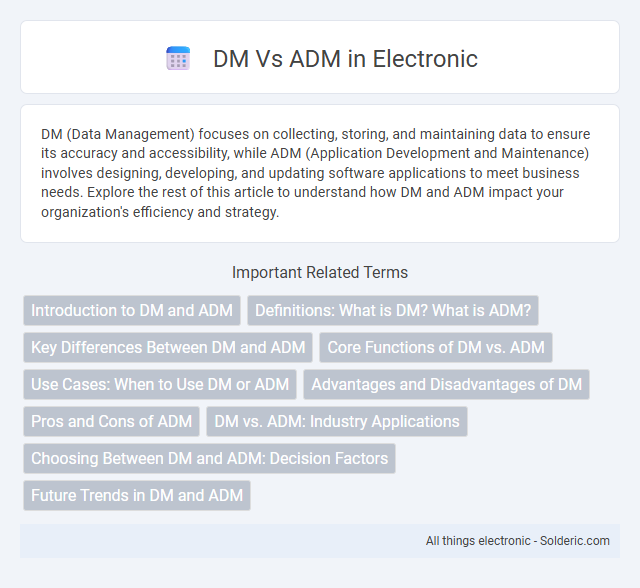DM (Data Management) focuses on collecting, storing, and maintaining data to ensure its accuracy and accessibility, while ADM (Application Development and Maintenance) involves designing, developing, and updating software applications to meet business needs. Explore the rest of this article to understand how DM and ADM impact your organization's efficiency and strategy.
Comparison Table
| Feature | DM (Data Modeling) | ADM (Application Data Modeling) |
|---|---|---|
| Definition | Process of creating a data structure for databases | Customized data modeling focusing on application-specific needs |
| Purpose | Design and organize data for storage and retrieval | Optimize data models for application performance and logic |
| Scope | Broad, database-centric | Application-level, specific to software requirements |
| Focus | Entities, relationships, and schema design | Data flow, usage patterns, and integration with app logic |
| Output | ER diagrams, schemas, normalization | Application data models, API data structures |
| Users | Database designers, architects | Developers, software architects |
Introduction to DM and ADM
Data Management (DM) involves the systematic collection, storage, and maintenance of data to ensure accuracy, accessibility, and security across an organization. Application Development and Maintenance (ADM) focuses on designing, implementing, and continuously improving software applications to meet business needs and enhance user experience. Understanding the distinct roles of DM and ADM helps optimize your IT infrastructure and aligns data handling with software performance.
Definitions: What is DM? What is ADM?
DM, or Decision Making, refers to the process of selecting a course of action from multiple alternatives based on evaluating information and potential outcomes. ADM, or Aeronautical Decision Making, specifically applies these principles within aviation, focusing on pilot judgment and safety while managing in-flight decisions. Understanding DM and ADM helps you improve critical thinking and risk assessment in various scenarios.
Key Differences Between DM and ADM
Direct Message (DM) and Automated Direct Message (ADM) differ primarily in their delivery method and personalization. DMs are sent manually by users, offering tailored and context-specific communication, while ADMs are generated by bots or automation tools to manage large-scale interactions efficiently. Key distinctions include the level of human involvement, response speed, and customization flexibility, where DMs provide a more personal touch compared to the standardized nature of ADMs.
Core Functions of DM vs. ADM
Data Management (DM) focuses on the core functions of collecting, storing, and maintaining data integrity to ensure accurate and accessible information across systems. Application Data Management (ADM) emphasizes managing data specifically within software applications, including data integration, synchronization, and user-centric customization to enhance application performance and user experience. Your choice between DM and ADM depends on whether your priority is broad organizational data governance or specialized application-level data handling.
Use Cases: When to Use DM or ADM
Direct Messaging (DM) is ideal for private, one-on-one communication or small group conversations that require quick, informal interactions and immediate responses. Asynchronous Direct Messaging (ADM) suits scenarios where recipients may respond at their convenience, such as in professional settings, remote teams, or customer support, enabling thoughtful, detailed communication without the pressure of real-time engagement. Selecting DM or ADM depends on the urgency of the message, the need for privacy, and the communication flow within the specific use case.
Advantages and Disadvantages of DM
Direct Messaging (DM) offers real-time, personalized communication that enhances customer engagement and quick resolution of queries. Its advantages include immediacy, privacy, and the ability to foster strong relationships through direct interaction, though its disadvantages involve limited scalability, potential for miscommunication, and the challenge of managing high volumes of messages efficiently. Unlike Automated Direct Messaging (ADM), DM relies heavily on human input, making it less efficient for handling repetitive inquiries but more effective for nuanced and complex conversations.
Pros and Cons of ADM
ADM offers the advantage of faster deployment and lower operational costs due to its centralized management and automation capabilities, making it ideal for scalable network environments. However, it can introduce complexity in integration with legacy systems and may require specialized skills to manage its advanced features effectively. The risk of a single point of failure in ADM systems also necessitates robust redundancy planning to ensure network reliability.
DM vs. ADM: Industry Applications
DM (Data Management) and ADM (Application Development and Maintenance) serve distinct purposes across industries, shaping operational efficiency and innovation. DM is critical in sectors like finance, healthcare, and retail for organizing, securing, and analyzing large datasets to support decision-making, compliance, and customer insights. ADM drives software lifecycle processes in technology, manufacturing, and telecommunications to enhance application performance, introduce new features, and ensure system reliability.
Choosing Between DM and ADM: Decision Factors
Choosing between Direct Message (DM) and Automated Direct Message (ADM) depends on your communication goals and audience engagement. DMs offer personalized, real-time interactions ideal for building authentic connections, while ADMs provide scalable, consistent messaging suited for marketing campaigns and customer support automation. Assess your priorities for customization versus efficiency to determine the best approach for your social media strategy.
Future Trends in DM and ADM
Future trends in Data Management (DM) emphasize increased adoption of AI-driven analytics and automation to enhance data quality and decision-making efficiency. Application Development and Maintenance (ADM) is progressing towards integrating low-code platforms and continuous delivery pipelines, enabling faster deployment and iterative improvements. Both DM and ADM are converging on cloud-native architectures to support scalability, real-time data processing, and seamless integration across enterprise ecosystems.
DM vs ADM Infographic

 solderic.com
solderic.com